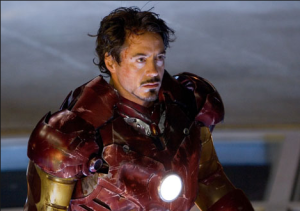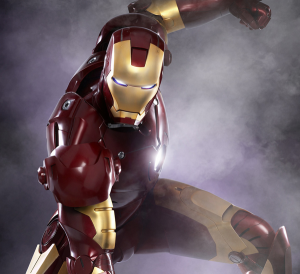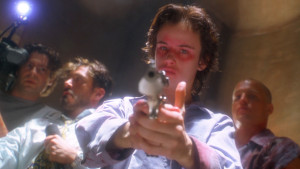The 40 Year-Old-Critic: Iron Man (2008)
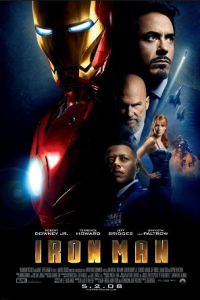 In The 40-Year-Old Critic, Venganza Media creator and host Arnie Carvalho recalls a memorable film for each year of his life. This series appears daily on the Venganza Media Gazette.
In The 40-Year-Old Critic, Venganza Media creator and host Arnie Carvalho recalls a memorable film for each year of his life. This series appears daily on the Venganza Media Gazette.
We truly live in the golden age of Marvel movies. In the past six years Marvel Studios (and now Disney) have set the standard for comic-based films, and racked up some of the highest-grossing hits of all time.
This year, the company proved how golden it really is with Guardians of the Galaxy, a film featuring a talking raccoon and his friend, the tree. On paper, that’s laughable. This movie shouldn’t have worked; the concept is so far removed from The Avengers that it conjures up memories of Howard the Duck (who even made a cameo).
But as I sit here typing this, Guardians has the designation of being 2014’s top grossing picture in the U.S.
It’s a wild success story that no one could have predicted — certainly I didn’t — back in 2008 when Marvel Studios released its first film: Iron Man.
As I detailed in my reviews of Superman and Spider-Man 3, I was a Marvel Comics fan in my teen years. At my peak I had several thousand comic books; long boxes stuffed with popular titles like Spider-Man, X-Men, and The Incredible Hulk, as well as Darkhawk, Ravage 2099, and Fantastic Four. Conspicuous perhaps by his absence, I didn’t own a single issue of Iron Man.
The character did make appearances in many comics I owned. Massive crossovers such as Secret Wars prominently featured the Armored Avenger. Yet none of those appearances made me feel like picking up an Iron Man comic. A businessman who pretends to be his own bodyguard in a suit of armor? The concept sounded pretty cheesy. The suit’s design, a garish red and yellow, also was a turnoff. He could fly. He could shoot lasers from his hands. And? Why would I want to read about that?
More, why would I want to see a movie about that?
The arm-chair studio moguls online and in magazines like Entertainment Weekly seemed to agree with me. Phrases like “B-list superhero (at best)” were used to describe Iron Man. It is hard to believe now, but just seven short years ago Iron Man had virtually no name recognition among the common public. Marvel had sold the movie rights to many its most well-known superheroes, including Spider-Man, Hulk, Wolverine and the X-Men, and those characters had gone on to star in their own pictures. Even other B-listers like Daredevil, Blade, and Ghost Rider had been picked up by other studios. What did Marvel have left?
They had Captain America, a man out-of-time goody-two-shoes. They had Thor, a Norse god that may have been even less well-known in his comic incarnation than Iron Man. They had The Incredible Hulk, who had a good history but a recent box-office disappointment thanks to Ang Lee’s Hulk. And they had Iron Man.
Yet Marvel had a vision. More, they had a plan. They didn’t release one film in 2008, they released two. They let it be known immediately that they were going to do on screen what they had done in their comics: create a shared universe where characters would cross over. The end game was announced before Iron Man was in theaters, Marvel wanted to assemble The Avengers.
I thought it was crazy talk. While, thanks to Harry Potter and Lord of the Rings it had become more common to have sequels in production, or even entirely filmed, before the first film was released. Even those seemed risky though, with pundits noting Lord of the Rings could have bankrupted New Line Cinema. Yet here Marvel Studios was going this route for its first features.
Iron Man didn’t excite me, but Marvel’s strategy sure got my attention. It was audacious, it was bold, and it was risky. I admired them before I ever saw a frame of the film.
Even crazier — they hired Robert Downey, Jr. to play Iron Man/Tony Stark. If you’ll recall, in the late 90s and early 2000s, Downey had a fairly toxic reputation in Hollywood. His well-publicized battle with addiction and his prison stints had branded him as unreliable. Worse, he was uninsurable — no company would put up a bond for the actor lest he again be arrested and his filmed scenes became unusable.
Despite his off-screen troubles, I had always been a fan of Downey. While I’d seen him in Weird Science and Back to School he first really caught my eye as someone to watch in The Pick-Up Artist, a film in which Downey is the only redeeming quality. I followed him for many years with Less Than Zero, Chances Are, Air America, hell I even watched Soapdish because he was in it. But two roles really defined Downey for me: his 1992 Oscar-nominated lead in Chaplin, and his role as a tabloid TV reporter in Natural Born Killers. But the more public his personal troubles became the more I felt he was an actor on the decline. I was really saddened by this — the man could act! From Two Girls and a Guy to U.S. Marshals to Kiss Kiss Bang Bang, I’d always been captivated by him.
That he was the star of Iron Man had me both worried and excited. On the one hand it seemed like on-the-nose casting — if I knew one thing about the Tony Stark character in comics it was that he was an alcoholic; if most people knew Downey for only one thing it was for his substance abuse problems.
The trailers with the rocking Black Sabbath track, Downey’s quick quips, the great action, and the effects — the film looked better than I expected; better than it deserved to look. Plus, rumors spread like wildfire that the film would include a cameo by Samuel L. Jackson as S.H.I.E.L.D. boss Nick Fury. By the time Iron Man was released, my curiosity was piqued.
Still, I was more interested in the second of Marvel’s one-two summer punch: The Incredible Hulk. I was a Hulk fan, he was the hero with name recognition; plus it had Edward Norton, an actor I believed was every bit as talented as Downey. But until Hulk came out I thought Iron Man could help me pass the time.
My expectations were low, but I was still there opening night to see Iron Man. I even drove 90 minutes to the closest new-fangled digital projector in the area.
The film, in short, rocked. I never expected to have so much fun in a superhero film. Movies like Blade, X-Men, and Batman Begins had seemed to say there was only one way to make a comic book movie, and that’s deadly serious. Iron Man eschewed that attitude with the flippant irreverence I’d expect from its main character. The movie did have its serious scenes, but the majority of the picture was filled with a kinetic energy and a constant sense of fun. I walked into the theater not getting Iron Man’s appeal; I walked out an Iron Man fan.
This was bolstered by Downey’s now-iconic performance. I couldn’t take my eyes off him. His jokes, his charisma, he owned this film. His line, “I am Iron Man,” was 100 percent accurate, for I couldn’t imagine this movie without him. Given the wide range of roles I’ve seen Downey portray I am hesitant to call this his best performance ever, but it is my favorite (with his 2008 follow-up Tropic Thunder a very close second).
Iron Man even brought Now Playing Podcast out of a brief retirement in 2008, and we followed up that short review with an even more extensive breakdown of the film for our Avengers Retrospective Series in 2012.
Yet, despite my love of the movie, I still thought Marvel’s overall strategy was ill-formed. Iron Man did well, Hulk did not. More, the only superhero film people seemed to remember from 2008 was Christopher Nolan’s The Dark Knight — a film that was more than a blockbuster, it was a cultural touchstone.
In 2008 it really seemed Marvel had lost the battle. More, they had no movies planned for 2009. Iron Man was a big enough hit to keep the wheels turning for Iron Man 2 in 2010 but I never thought Marvel could go the distance. Avengers seemed like a pipe dream.
Again, I bet wrong. Iron Man 2 built on the brand in 2010, and the following year saw two more Marvel films, Thor and Captain America: The First Avenger. Both did respectable business, but neither broke the $200 million domestic mark to be qualified as a blockbuster. They didn’t need to; Marvel was playing the long game, they were building a brand.
It paid off — big time. The Avengers took the world by storm. It almost seemed a rematch of Marvel versus DC as, that same year, Nolan returned with The Dark Knight Rises. Iron Man once again faced Batman, but this time Stark brought his friends and when 2012 ended it was The Avengers that had become the benchmark for comic book movies. Sorry, Batman.
Marvel Studios’ brazen gambit paid off in spades. Not only has the company become an unstoppable movie juggernaut, they have expanded their cinematic universe to weekly network television, to four different Netflix series’, and even drawn plans for up to three movies per year in the future.
Other studios now desperately try to ape Marvel’s success. After trying for 20 years to get Batman and Superman on screen together, next year finally brings us Batman v Superman: Dawn of Justice, with a list of superheroes that include Wonder Woman, Cyborg, and — according to rumor — Aquaman, the Flash, and others. DC is now playing catch-up to Marvel.
Even other studios with Marvel properties have tried to follow this formula, though to less success. The same year The Avengers was released Sony tried to build its own multi-chapter story with The Amazing Spider-Man. This year they announced that a Spidey universe of films is coming, including two spin-offs featuring villains — Sony is now grasping for whatever characters to which they hold rights. At 20th Century Fox, studio executives also bet big-time on their X-Men franchise, bringing back original director Bryan Singer to revitalize the series. The Marvel Studios tactic of ending each film with a “stinger” to tease the next picture is now so commonplace, audience members are afraid to leave the theater before the end credits are finished.
Yes, for the past 6 years movies have been following Marvel Studios’ formula. It all started with a big gamble that paid off: Iron Man.
As for me, Iron Man opened a door that had been cracked the year before with Spider-Man 3. The Marvel movies were really an exciting property to follow. My dormant comic fandom was back with a vengeance. Marjorie, knowing my love of Iron Man, bought me my first high-end Marvel collectibles: a Hot Toys “Mech Test” Tony Stark figure, as well as a Kotobukiya Iron Man statue. The door was opened and before long the podcast Marvelicious Toys was launched as a companion piece to Star Wars Action News, focusing specifically on Marvel collecting.
More, Marvel Studios’ films had me wanting to build up to The Avengers. Now Playing Podcast had been following, almost exclusively, the retrospective format in 2009 and 2010, but after seeing Iron Man 2 I pitched to co-hosts Stuart and Jakob the craziest, biggest retrospective yet: every Marvel movie ever. Up until then our series’ had all been of manageable length of a dozen films or less. It took a year of discussion. First, Stuart thought we should only do the six Marvel Studios films. Then he thought we should do the major franchises. Finally he agreed to all theatrical films, and we had started Now Playing’s Complete Marvel Movie Retrospective. Over time I was even able to find a back door — several 1970s TV movies had aired in theaters in foreign countries.
It put Now Playing on a path to greater success, as described in my review of Howard the Duck — our first review in that very long series.
Yet while I still ride the high Iron Man gave me in 2008, bolstered regularly by a new “fix” from Marvel Studios, I do wonder how long this will last. Movies are defined by trends; after Star Wars every studio fast-tracked their space films, but by the mid-80’s those had become passé; after Gremlins any script with tiny attackers, from Ghoulies to Critters was given the green light. The cases of Hollywood me-too-ism are legion, but they all have one thing in common: they end when the next big thing comes along.
I often ruminate on what that next trend will be, and when audiences will tire of the serialized cinema storytelling and prefer movies that provide a singular experience with no “to be continued…” at the end. I have no doubt that day will come, but I think we’re in for many more years of the Marvel Age of cinema before we get there.
Tomorrow — 2009!
Arnie is a movie critic for Now Playing Podcast, a book reviewer for the Books & Nachos podcast, and co-host of the collecting podcasts Star Wars Action News and Marvelicious Toys. You can follow him on Twitter @thearniec
September 7, 2014 Posted by Arnie C | 40-Year-Old Critic, Comic Books, Movies, Reviews | 2000s, 40-Year-Old Critic, Avengers, Batman, Captain America, Collecting, Comic Books, Comics, Enertainment, Film, Hot Toys, Iron Man, Marvel, Marvel Comics, Marvelicious Toys, Movie, Movies, Now Playing, Now Playing Podcast, Podcasts, Review, Reviews, Robert Downey Jr, sci-fi, Sideshow Collectibles, Spider-Man, Statues, Tony Stark, Toys, X-Men | Comments Off on The 40 Year-Old-Critic: Iron Man (2008)
40 Year-Old-Critic: Natural Born Killers (1994)
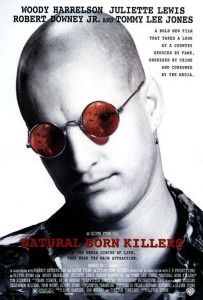 In The 40-Year-Old Critic, Venganza Media creator and host Arnie Carvalho recalls a memorable film for each year of his life. This series appears daily on the Venganza Media Gazette.
In The 40-Year-Old Critic, Venganza Media creator and host Arnie Carvalho recalls a memorable film for each year of his life. This series appears daily on the Venganza Media Gazette.
Mister rabbit says, “A movie review is worth a thousand prayers.”
In 1994 I was in college with aspirations of filmmaking. While my university did not have a dedicated film curriculum, my Mass Media Communications major with a Creative Writing minor afforded me classes in screenwriting, film criticism, editing, camerawork, and more.
But as the major was not simply film, there were numerous other classes I had to take for my degree. The list included Communication Ethics, First Amendment rights, studies of media impacts on the audience, and journalism, to name a few. As a college junior, I lived and breathed my major. Every form of entertainment I enjoyed, from video games to television to books to film, was a subject for my college studies. I wrote papers and gave multimedia presentations on violence in film, with a special focus on the Friday the 13th and Nightmare on Elm Street franchises.
But that year produced something unexpected from Oliver Stone and Quentin Tarantino. I was used to films factoring into my curriculum, but I never expected a major motion picture to be studying the same topic.
Natural Born Killers did just that.
The story is pure Tarantino. Having rewatched both True Romance and Reservoir Dogs multiple times I instantly saw a familiar trope in Mickey and Mallory Knox — the killers/anti-heroes of this film. Seeing two young outlaws in love and on a crime spree seemed right out of True Romance. That they are also merciless murderers felt like an extension of some of the characters from Reservoir Dogs — Mickey and Mallory could be Mr. and Mrs. Blonde. Finally, the film has a non-linear narrative that ends in a Mexican standoff. Despite Tarantino distancing himself from the production I saw his fingerprint on the negative.
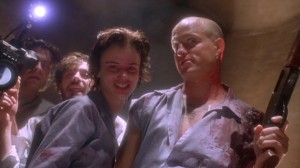
Despite the carnage, there was something pure and romantic about Mickey and Mallory’s love affair. It was sick and twisted, but also sweet.
I did later read the original script, which was published in book form. That draft was far more Tarantino, but still a reach for the director. More than a crime film, Tarantino’s Natural Born Killers had a pointed critique on American tabloid journalism.
Yet, in the hands of Oliver Stone, the film’s focus on the media grew exponentially. Stone, along with screenwriters David Veloz and Richard Rutowski, rewrote the script to the point that Tarantino ended up only receiving story credit. In the hands of Stone’s team, Natural Born Killers became a scathing commentary on American media.
It could not have hit at a more appropriate time. Rush Limbaugh was scoring big on radioand television with his daily indictment of the Clinton administration. Meanwhile the country was transfixed by the O.J. Simpson case. While this movie was released a few months before the trial began, the Ford Bronco chase and Simpson’s arrest were constant news.
The media focus seemed to go from one real-life drama to the next, be it Amy Fisher, Tonya Harding, Heidi Fleiss, the Menendez brothers, or even Woody Allen’s divorce from Mia Farrow — all were fodder for the newspapers and 24-hour news channels. What had once been the domain of the National Enquirer was suddenly considered “real news.” It seemed everyone was being given a talk show, and those who couldn’t host a show tried to get their 15 minutes of fame by appearing on one.
It’s ironic that Stone undertook this film as a chance to make a simple action picture, but he doesn’t do “simple.” As such, the result is an indictment not only of the media companies that propagate such coverage, but also the populace that consumes it.
Mickey and Mallory Knox, as brought to life by Woody Harrelson and Juliette Lewis, are products of the media. Despite Harrelson being in his early 30s when this film was made, Mickey and Mallory feel like members of the “MTV Generation.” These two realize they will never be TV stars, so they’ll be the next best thing: headline-makers. They guarantee it, always leaving one person alive to tell the media about Mickey and Mallory.
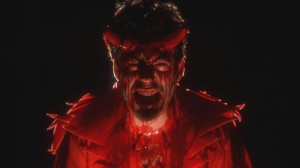
Stone has never been accused of being too subtle.
The journalists are not left untouched, though. The second half of the movie gets a shot of adrenaline in the form of Robert Downey, Jr., turning in a tremendous performance as tabloid TV reporter Wayne Gale. With an affected Aussie accent and an equally affected sympathetic persona, Gale convinces Mickey to do his first TV interview. As the film’s madness grows Gale starts to believe his own press, and eventually realizes the time comes when the audience wants to turn the TV off.
From the first frame to the last, Natural Born Killers is a film about the superficiality of personas, examining the concept of who a person is versus how he/she wants to be seen. While that difference is often greatest in the cases of public figures who must act a certain way in public but may be very different behind closed doors, the script shows that everyone has that secret face. The insight to that is Detective Jack Scagnetti (Tom Sizemore), who appears to be the heroic cop who brings down Mickey and Mallory. Yet the audience sees that he is a mirror image to Mickey. While Mickey kidnaps, rapes, and murders an innocent woman, Scagnetti hires, screws, and strangles a hooker.
Every character in the film is disgusting and immoral–save one Navajo Indian from whom Mickey and Mallory seek shelter. This character calls out blatantly that the two killers watch “too much TV.” While the mystical, magical medicine man is a blatant stereotype, he is the only character in the film who doesn’t deserve a bullet (but he gets one anyway). The police, the media, Mallory’s parents, even the random stranger Mallory seduces at a gas station, are all contemptible and repugnant.
In other words, they’re the product, creators, and consumers, of tabloid journalism.
Yet, for all of the high-minded idealism of the movie, Natural Born Killers avoids the usual “message movie” pitfall of heavy-handedness, which I discussed in my review of Philadelphia.
Stone’s filmmaking is too frenetic, too fast-paced, to ever linger. The film’s style changes with the scene; one moment we are seeing Mallory’s family portrayed as a sitcom, complete with laugh track, the next we have grainy black-and-white footage. There are even animated sequences inserted into the film that visualize the emotion of a scene. There is no way for the film to linger, there is too much going on.
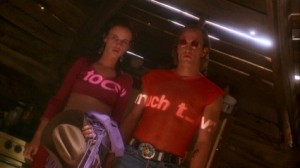
Something as simple as projecting a slide on actors felt fresh among the ever-shifting styles in Natural Born Killers.
In that regard, the picture is a critique of its audience. Stone knew that moviegoers in the 1990s had short attention spans, so he created a film perfectly suited to the mindset of an ADD-addled channel-flipper. The story and characters remain the same, but the tone, even the film stock, continually change. Stone also inserts bits of real commercials, as if he holds the remote we’re watching him scan to see what else is on.
The result is a trippy, psychedelic movie that truly feels like a tonal companion piece to his 1991 film The Doors. Mickey and Mallory are also rock stars of the media, and they even seek guidance from the spiritual Native American.
Like that earlier Stone film, Natural Born Killers is an experience more than a narrative. The color pallette, the transition to animation, the first-person camera shots years before found footage films were en vogue, the result is less narrative and more emotional.
And like The Doors, Natural Born Killers is propelled by a strong soundtrack. While the former film was almost exclusively set to Jim Morrison’s music, it was limited by the subject matter. Natural Born Killers doesn’t have that limitation, and the styles of music represented are as scattered as the film techniques.
Stone collaborated with Nine Inch Nails’ Trent Reznor to produce the soundtrack, and the result is a thumping, yet moody, symphony of discord. Music from Patsy Cline is interwoven with Patti Smith, Bob Dylan, L7, Dr. Dre, and much more — with a healthy dose of Leonard Cohen at the beginning and end.
Listening to the soundtrack is almost as involving an experience as watching the film. Reznor did not simply follow the Reservoir Dogs formula of putting film clips on the CD, he actually mixed it with the music, creating an aural cinematic experience.
(Though for those of us who are musical purists, it also ensured I bought many of the bands’ original albums to have versions of the songs without added effects and dialogue. It was this album that set me on the road to Leonard Cohen super-fandom.)
This entire tone could have been undercut by the lead actors, but Stone directed his cast expertly. All the leads, and key supporting characters, have left realism at the door. Exaggeration is the name of the game, so lines are screamed or drawled, movements emphasized, and facial expressions broad. Alone, that type of acting could undermine a film, but with the crazed visuals that accompany the scenes anything more natural would be lost.
The standout of the cast is Harrelson. Much like Tom Hanks with Philadelphia, I knew Harrelson from his comedies — not just Cheers, but Doc Hollywood, White Men Can’t Jump and even The Cowboy Way. I worried he could not pull off a performance as a homicidal maniac. More, as Harrelson was the son of a hit man who may have been involved in the John F. Kennedy assassination, it felt like stunt casting of the worst type.
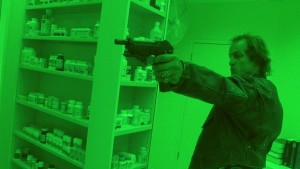
Harrelson left behind his good-ol-boy persona and fully inhabited the homicidal persona of Mickey Knox.
I was again wrong as I watched Harrelson, head shaved, fall into the character. By the film’s climax — when he has to break the fourth wall and deliver the line “I’m just a natural born killer” — all thoughts of comedy were gone. He was just a bad-ass, homicidal, rock star.
His performance is clearly aided by those of his co-stars. Lewis, a quirky actress I first noticed with 1993’s Cape Fear, is perfectly cast as a psychotic who becomes empowered and emancipated by following Mickey’s murderous examples. Sizemore carries a sleazy menace that follows him to every frame. Even Tommy Lee Jones overacts to the heavens as the spiteful prison warden. The result is a cast in perfect harmony, complimenting each other and their movie.
When I saw this film in theaters opening weekend I was mesmerized. I walked out, my head full of new viewpoints that I could incorporate into my coursework. I went back the very next day to try and catch more of the film, and to again experience the weird acid trip it offered.
Natural Born Killers spoke to me at a time in my life where I was already receptive to its message. I walked in expecting a road movie featuring mass murderers. I left thinking about media, and my own role in its creation.
But like Stone’s earlier film Wall Street, I feel the message of Natural Born Killers has been lost at best, or perverted at worst. Several instances of “copycat crimes” have appeared in the media, killers completely missing the point and, instead, are seemingly inspired by Mickey and Mallory Knox. It’s impossible to say if those acts would have been done without this film, but it’s a sad irony that a movie about the dangers of media violence then creates its own.
Yet every day when I look at the news, I feel that Natural Born Killers did not succeed in warning the media, or its consumers, about the impact of tabloid journalism. From Britney Spears’ head-shaving incident to Charlie Sheen’s “winning” display to even Robin Williams’ tragic suicide, the media is there to try and grab big ratings under the guise of informing the public.
On TV, audiences laughed at the obviously drugged antics of Anna Nicole Smith, until she died from her drugs. Audiences insist on Keeping Up with the Kardashians and watching Honey Boo Boo, The Bachelor or Catfish. Producers and editors sculpt clips from those shows, take sound bites out of context, and spend thousands of hours creating an audience-pleasing narrative of good versus bad that may have little bearing on reality.
I don’t know if fans of these shows a) don’t realize they manipulate the stars and their audience, or b) don’t care. Either way, we continue down the spiral to Stone’s original vision.
But if Natural Born Killers’ message didn’t last, the film didn’t stick with me either. Through my college years Stone’s film was in heavy rotation on my VCR. When the VHS release of the Director’s Cut came in 1997 (so long it had to be on two tapes) I rented it the first day. That was when I felt the trippy effect had finally worn off and I was no longer under the movie’s spell.
The scenes cut from Natural Born Killers — available on the second VHS tape — had every reason to be cut. I watched the extra hour Stone filmed for this movie and realized that, truly, this was a film made in the editing bay and not on the set. Assembling all the footage, including the cut trial scene and Mickey and Mallory’s attack on wrestling brothers Simon and Norman Hun, I realize Stone had a production out of control. The behind-the-scenes knowledge soiled this film for me, and for a decade I had trouble watching it at all. Now I can credit the final product, knowing how bad this movie almost was.
But in the fall of 1994 two Tarantino scripts were in theaters simultaneously: Natural Born Killers and Pulp Fiction. The masses crowded around Fiction, and Tarantino took home Oscar gold.
I greatly enjoy that second Tarantino-directed film, but if you asked me in the mid-90s to name my favorite of those two works, it had to be Natural Born Killers.
Tomorrow — 1995!
Arnie is a movie critic for Now Playing Podcast, a book reviewer for the Books & Nachos podcast, and co-host of the collecting podcasts Star Wars Action News and Marvelicious Toys. You can follow him on Twitter @thearniec
August 24, 2014 Posted by Arnie C | 40-Year-Old Critic, Movies, Now Playing Podcast, Podcasts, Reviews | 1990s, 40-Year-Old Critic, Juliette Lewis, Mallory, Mickey, Movie, Movies, Natural Born Killers, Nine Inch Nails, Now Playing, Now Playing Podcast, Oliver Stone, Podcasts, Review, Reviews, Robert Downey Jr, Trent Reznor, TV series, Woody Harrelson | 2 Comments
Pre-Order Alert: Sideshow 20-inch Iron Man Mk 42 Maquette
It’s time to pre-order the new bad-ass baby brother of Tony Stark’s armor collection — the Mark 42 armor from Iron Man 3!
Working with Legacy Effects, the company behind Iron Man 3’s impressive visuals, Sideshow Collectibles has now created what they call “the ultimate screen-accurate representation of Stark in his latest and greatest armor.”
This piece is called a “maquette” but it is a perfect fit for the Sideshow Premium Format line of Marvel Cinematic Universe figures. Built to one-quarter scale (20 inches tall!) with exacting detail and a tremendous likeness of Robert Downey Jr. this statue is sure to rock your collection!
Pre-orders are open now, so secure your order today at SideshowCollectibles.com!
June 12, 2014 Posted by Arnie C | Marvelicious Toys, Movies, News, Podcasts | Collecting, Iron Man, Marvel, Marvel Comics, Marvelicious Toys, Movie, Movies, News, Pre-Order, Premium Format, Robert Downey Jr, Sideshow Collectibles, Statues, Toys | Comments Off on Pre-Order Alert: Sideshow 20-inch Iron Man Mk 42 Maquette
-
Archives
- February 2021 (1)
- January 2021 (1)
- December 2020 (1)
- November 2020 (3)
- October 2020 (2)
- September 2020 (1)
- August 2020 (2)
- July 2020 (1)
- June 2020 (1)
- May 2020 (1)
- April 2020 (3)
- March 2020 (2)
-
Categories
-
RSS
Entries RSS
Comments RSS
Site info
Venganza Media GazetteTheme: Andreas04 by Andreas Viklund. Get a free blog at WordPress.com.
